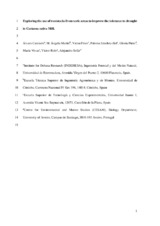Mostrar el registro sencillo del ítem
Exploring the use of scions and rootstocks from xeric areas to improve drought tolerance in Castanea sativa Miller
| dc.contributor.author | Camisón, Álvaro | |
| dc.contributor.author | Martín, Mª Ángela | |
| dc.contributor.author | Flors, Víctor | |
| dc.contributor.author | Sánchez-Bel, Paloma | |
| dc.contributor.author | Pinto, Gloria | |
| dc.contributor.author | Vivas, María | |
| dc.contributor.author | Rolo, Víctor | |
| dc.contributor.author | Solla, Alejandro | |
| dc.date.accessioned | 2024-01-18T13:20:53Z | |
| dc.date.available | 2024-01-18T13:20:53Z | |
| dc.date.issued | 2021 | |
| dc.identifier.uri | http://hdl.handle.net/10396/26608 | |
| dc.description.abstract | Nut production by the European sweet chestnut (Castanea sativa Mill.) in grafted orchards is under threat of increased drought stress associated with current global warming. To explore whether drought tolerance in C. sativa could be improved using drought tolerant scions and rootstocks, trees from humid (H) and xeric (X) populations in Spain were used to generate intra-family (H/H and X/X) and reciprocal inter-location (X/H and H/X) grafts. We studied the effects of the (i) scion, (ii) rootstock and (iii) the grafting itself as a wounding stress on the vegetative budbreak, secondary growth and drought tolerance of C. sativa trees. Drought tolerance was assessed by measuring leaf gas exchange, chlorophyll fluorescence, water status and leaf wilting two weeks after water deprivation. Hormone (ABA, SA, JA and JA-Ile) and proline quantification in tree leaves and fine roots were assessed, as well as tree and scion mortality. Rootstocks and scions of xeric origin induced earlier flushing and improved drought tolerance of scions and rootstocks of humid origin. Tree mortality after drought was 57 % lower in H/X than in H/H trees, and scion loss after drought was 47 % lower in H/X than in X/H trees. The ‘grafting’ (i.e., wounding) effect delayed vegetative budbreak and reduced secondary growth of trees but did not predispose trees to drought. We report for the first time differences in hormone and proline content in leaves and fine roots of chestnut trees of humid and xeric origins exposed to drought. The results suggest the use of scions and rootstocks from xeric areas to improve drought tolerance in chestnut. | es_ES |
| dc.format.mimetype | application/pdf | es_ES |
| dc.language.iso | eng | es_ES |
| dc.publisher | Elsevier | es_ES |
| dc.rights | https://creativecommons.org/licenses/by-nc-nd/4.0/ | es_ES |
| dc.source | Camisón, Á., Martı́n, M.Á., Flors, V., Sánchez-Bel, P., Pinto, G., Vivas, M., Rolo, V., & Solla, A. (2021). Exploring the use of scions and rootstocks from xeric areas to improve drought tolerance in castanea sativa miller. Environmental and Experimental Botany, 187, 104467. https://doi.org/10.1016/j.envexpbot.2021.104467 | es_ES |
| dc.subject | ABA, Climate change Grafting Hormonal profiling JA-Ile Orchard management | es_ES |
| dc.subject | ABA | es_ES |
| dc.subject | Climate change | es_ES |
| dc.subject | Grafting | es_ES |
| dc.subject | Hormonal profiling | es_ES |
| dc.subject | JA-Ile | es_ES |
| dc.subject | Orchard management | es_ES |
| dc.title | Exploring the use of scions and rootstocks from xeric areas to improve drought tolerance in Castanea sativa Miller | es_ES |
| dc.type | info:eu-repo/semantics/article | es_ES |
| dc.relation.publisherversion | https://doi.org/10.1016/j.envexpbot.2021.104467 | es_ES |
| dc.relation.projectID | Gobierno de España. AGL2014-53822-C2-1-R | es_ES |
| dc.rights.accessRights | info:eu-repo/semantics/openAccess | es_ES |

